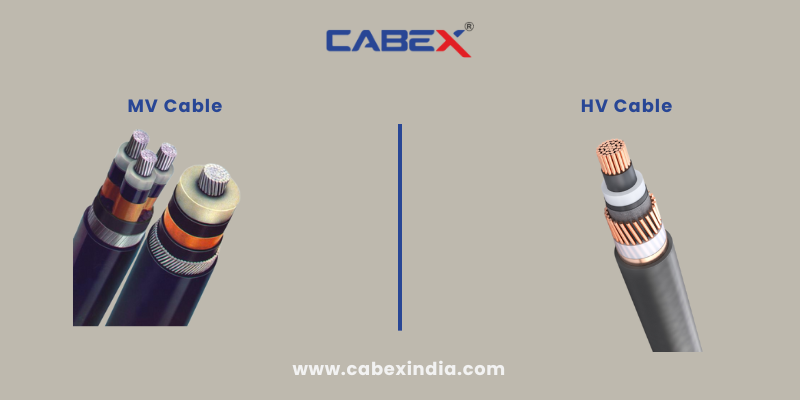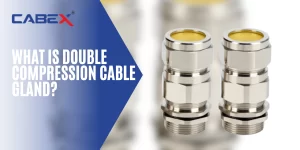Introduction
Difference Between MV Cable and HV Cable. In the expansive realm of electrical infrastructure, where power distribution and transmission play pivotal roles, the nuances of various cable types can often be mystifying. Among the many distinctions that professionals in the field must be well-versed in, one frequently encountered question is, “What is the Difference Between MV Cable and HV Cable?” To unravel this enigma, we delve into the intricate world of medium-voltage (MV) and high-voltage (HV) cables, shedding light on their characteristics, applications, and key disparities.
Medium-Voltage (MV) Cable
Medium-voltage (MV) cables constitute a vital segment of electrical networks, seamlessly delivering power across various applications. Generally, MV cables are designed to operate within voltage ranges spanning from 1 kV (1000 volts) to 36 kV (36,000 volts). This range positions MV cables as the bridge between low-voltage (LV) and high-voltage (HV) cables in the electrical hierarchy.
Characteristics of MV Cables
MV cables are renowned for several distinguishing features, each tailored to its intended purpose:
- Insulation Materials: MV cables often employ a plethora of insulation materials, such as cross-linked polyethylene (XLPE) and ethylene propylene rubber (EPR). These materials provide excellent dielectric properties, ensuring the safe transmission of electricity.
- Conductor Materials: Copper and aluminum are the prevalent choices for MV cable conductors. Copper, known for its exceptional conductivity, is employed in critical applications, while aluminum offers cost-efficiency without sacrificing performance.
- Armoring: MV cables may be armored or unarmored. Armored variants utilize metallic sheaths, enhancing mechanical protection and safeguarding against external influences.
- Application Flexibility: These cables are versatile, suitable for both underground and overhead installations, making them ideal for various industries, including utilities, industrial facilities, and renewable energy projects.
- Voltage Ratings: MV cables, as the name suggests, operate within medium voltage ranges, catering to voltage levels typically found in secondary distribution networks and medium-sized industrial installations.
High-Voltage (HV) Cable: An Overview
Contrasting with medium-voltage cables, high-voltage (HV) cables are engineered to tackle the rigorous demands of transmitting electricity over longer distances at elevated voltage levels. HV cables are designed to operate in the range of 36 kV to 550 kV, making them the stalwarts of long-distance power transmission.
Characteristics of HV Cables
HV cables are distinguished by several notable characteristics, tailored to their specific purpose:
- Insulation Materials: HV cables demand insulation materials capable of withstanding extreme electric stress. Paper impregnated with oil (often referred to as paper-oil insulation) is a traditional choice for these cables, offering excellent electrical properties.
- Conductor Materials: Copper and aluminum, much like in MV cables, are prevalent conductor materials for HV cables. Copper’s conductivity remains advantageous, while aluminum’s lighter weight suits the demands of lengthy overhead transmission lines.
- Metallic Shielding: HV cables typically incorporate metallic shields, such as lead or aluminum, to minimize electric field stresses and control the distribution of voltage gradients.
- Complex Cable Structures: Due to the high voltages involved, HV cables often feature complex cable structures, including insulation layers, metallic shields, and semi-conductive screens, ensuring the safety and reliability of long-distance power transmission.
- Long-Distance Transmission: The primary role of HV cables is to facilitate the efficient and reliable transmission of electricity over extensive distances, connecting power generation facilities with distribution networks and substations.
Key Difference Between MV Cable and HV Cable
Now that we have explored the fundamental characteristics of both MV and HV cables, let’s highlight the key difference between MV cable and HV cable, that set them apart:
- Voltage Range:
- MV Cable: Operates within the range of 1 kV to 36 kV.
- HV Cable: Operates within the range of 36 kV to 550 kV.
- Applications:
- MV Cable: Suited for medium-voltage applications, such as secondary distribution networks, industrial facilities, and renewable energy projects.
- HV Cable: Designed for long-distance power transmission, connecting power generation facilities to substations and distribution networks.
- Insulation Materials:
- MV Cable: Employs materials like XLPE and EPR, offering good dielectric properties.
- HV Cable: Utilizes specialized insulation materials, often paper-oil, to withstand extreme electric stress.
- Conductor Materials:
- MV Cable: Typically uses copper or aluminum conductors based on application requirements.
- HV Cable: Also employs copper and aluminum conductors, with a focus on suitability for lengthy transmission lines.
- Metallic Shielding:
- MV Cable: May or may not include metallic shielding, depending on the specific application and requirements.
- HV Cable: Often incorporates metallic shields like lead or aluminum to manage electric field stresses.
- Complexity:
- MV Cable: Generally features simpler cable structures.
- HV Cable: Tends to have complex cable structures to ensure safety and reliability over long distances.
- Distance of Transmission:
- MV Cable: Primarily used for relatively short-distance transmission within localized areas.
- HV Cable: Specialized for the transmission of electricity over extensive distances, often spanning hundreds of miles.
Selecting the Right Cable for the Job
Choosing between MV and HV cables hinges on the specific requirements of a given electrical infrastructure project. Here are some considerations to guide the selection process:
When to Choose MV Cables:
- Medium-Voltage Grids: Opt for MV cables when you are dealing with medium-voltage grids, such as those found in urban and suburban areas for secondary distribution.
- Industrial Facilities: MV cables are well-suited for industrial applications where medium voltage is sufficient for powering machinery and equipment.
- Renewable Energy Projects: MV cables are commonly used in renewable energy installations, connecting solar farms and wind turbines to the grid.
- Cost Efficiency: If budget constraints are a concern and the transmission distance is limited, MV cables can be a cost-effective choice.
When to Choose HV Cables:
- Long-Distance Transmission: HV cables are the go-to option for transmitting electricity over vast distances, linking power generation sources to distant substations and distribution networks.
- High-Voltage Grids: In areas with high-voltage transmission grids, HV cables are essential for maintaining efficient power transfer.
- Interconnected Grids: When connecting multiple power grids or regions, HV cables ensure seamless energy exchange.
- Reliability and Voltage Stability: For critical applications where voltage stability and reliability are paramount, HV cables provide the necessary assurance.
The Role of Cable Accessories
In the world of MV and HV cables, it’s essential to consider not only the cables themselves but also the associated accessories. These accessories play a pivotal role in ensuring the proper functioning and longevity of the cables. Some common cable accessories include:
- Terminations: These are used to connect the cable to electrical equipment or other cables, providing a seamless transition and maintaining electrical integrity.
- Joints: Cable joints are utilized to connect two cable sections, ensuring electrical continuity and protecting against environmental factors.
- Splices: Splices are similar to joints but are used to connect cables of the same type and size.
- Cable Lugs and Connectors: These components facilitate the connection of cables to electrical equipment, such as transformers and switchgear.
- Cable Glands: Glands are employed to seal cable entry points into electrical enclosures or equipment, preventing moisture and contaminants from entering.
Safety Considerations
Regardless of whether you are working with MV or HV cables, safety should always be a paramount concern. Handling electricity at any voltage level requires adherence to rigorous safety protocols and standards. Here are some general safety considerations for working with both MV and HV cables:
- Qualified Personnel: Ensure that only qualified and trained personnel handle the installation, maintenance, and repair of cables.
- Protective Gear: Proper personal protective equipment (PPE), such as insulated gloves, eyewear, and clothing, should be worn when working with cables.
- Testing and Inspections: Regularly conduct testing and inspections to identify any potential issues with the cables or associated equipment.
- Isolation and Lockout/Tagout: Implement isolation and lockout/tagout procedures to de-energize cables and equipment before performing any work.
- Environmental Considerations: Take into account environmental factors, such as temperature and moisture, that can affect cable performance.
- Compliance: Ensure compliance with relevant safety standards and regulations, as non-compliance can lead to dangerous situations.
Conclusion
In summary, the Difference Between MV Cable and HV Cable primarily lies in their voltage ranges, applications, and the complexity of their designs. While MV cables are well-suited for medium-voltage grids and localized applications, HV cables shine when it comes to long-distance power transmission and high-voltage grids. The selection of the right cable for a particular project should be based on careful consideration of voltage requirements, transmission distances, and budget constraints. Additionally, prioritizing safety and compliance with industry standards is crucial when working with any type of electrical cable. By understanding these distinctions and adhering to best practices, professionals in the field can ensure the efficient and reliable distribution of electrical power.
FAQ
What is the main difference between MV and HV cables?
The primary difference between MV (Medium-Voltage) and HV (High-Voltage) cables is their voltage range. MV cables operate within the range of 1 kV to 36 kV, while HV cables operate in the range of 36 kV to 550 kV and beyond. This voltage distinction dictates their specific applications and characteristics.
Where are MV cables typically used?
MV cables are commonly employed in applications that require medium-voltage power distribution. These include secondary distribution networks, industrial facilities, renewable energy projects, and areas where medium voltage is sufficient for powering equipment.
What are the typical applications for HV cables?
HV cables are primarily used for long-distance power transmission, connecting power generation facilities, such as power plants or wind farms, to distant substations and distribution networks. They are essential in high-voltage grids and interconnecting power grids.
What are the key characteristics of MV cables?
MV cables often feature insulation materials like cross-linked polyethylene (XLPE) or ethylene propylene rubber (EPR), can use copper or aluminum conductors, and may or may not have metallic shielding. They are versatile, suitable for both underground and overhead installations.
Are there cost differences between MV and HV cables?
Yes, there are cost differences. MV cables tend to be more cost-effective for shorter-distance applications due to their lower voltage ratings. HV cables, designed for long-distance transmission, are typically more expensive due to their specialized construction and materials.






